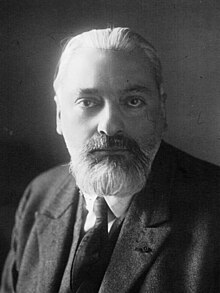Claude Farrère
Claude Farrère , actually Frédéric Charles Bargone (born April 27, 1876 in Lyon , Département Rhône , † June 21, 1957 in Paris ) was a French writer.
Life
Bargone came from an old family of officers, his father a senior naval officer. He also embarked on a military career in the French Navy. After attending the naval school , he served in various posts and left after the First World War in the rank of corvette captain of the armed forces to devote himself only to his literary works.
The Académie française elected Claude Farrère ( armchair 28 ) as the successor to the politician Louis Barthou , who died in 1934 .
Claude Farrère died in Paris on June 21, 1957 at the age of 81 and was also buried there.
reception
Farrère was mainly influenced in his writing by Pierre Louÿs and Victor Segalen and, according to his own admission, he had the greatest respect for Pierre Loti and his work.
The perfumer Guerlain in Paris was inspired by Farrère's novel The Marquise Yorisaka (La Bataille) and created his perfume of the same name based on the protagonist “Mitsouko”.
Honors
- 1905 Prix Goncourt for his novel Les Civilisès .
- In Paris ( 16th arrondissement ), in Lyon ( 3rd arrondissement ) and in Ermont ( Département Val-d'Oise ) streets were named after him in his honor.
- His work Stamboul led Kemal Ataturk to name a street in the Sultanahmet district in the former Eminönü district of Istanbul (Klodfarer Caddesi).
- The École Claude Farrère in Saint-Priest ( Métropole de Lyon ) also bears his name
- The Prix Claude-Farrère was named after him in 1959.
Works (selection)
Fiction
- Novellas
- Dix-sept histoires des marins . 1914.
- Quatorze histoires de soldats . Flammarion, Paris 1916.
- From four parts of the world. Novellas . Kaemmerer publishing house, Berlin 1925.
- Novels
- The secret of the living. ( La maison des hommes vivants. 1911). German book club, Berlin 1928.
- L'homme qui étaite trop grand . Paris 1936 (with Pierre Benoit)
- A young girl traveled. Novel. ( Une jeune fille voyagea. 1925). Publishing house Die Buchgemeinde, Berlin 1933.
- Miss Dax.Roman.Verlag Georg Müller, Munich
- The little allies. Novel. ( Les petites alliées. 1910). Thespis-Verlag, Munich 1920.
- People of culture. Novel. ( Les civilisés. 1905). Georg Müller Publishing House, Munich 1926.
- The last god. Novel. ( Le dernier dieu. ). Kiepenheuer, Potsdam 1928.
- The man who committed murder. Novel. ( L'homme qui assassina. 1906). Rütten & Loening, Frankfurt / M. 1909.
- The Marquise Yorisaka. Novel. ( La bataille. 1909). Georg Müller Publishing House, Munich 1928.
- Opium, novellas. ( Fumée d'opium. 1904). Georg Müller Publishing House, Munich 1926.
- Rivals . Maschler, Berlin 1929.
- Pirates. Novel. ( Thomas L'Agnelet, gentilhomme de fortune. 1911). Georg Müller Publishing House, Munich 1923.
- The doomed. Novel. ( Les condamnés à mort. 1921). Drei Masken Verlag, Munich 1921; German book club, Berlin 1925.
- Plays
- L'école de jazz. Comédie en 4 acts . 1927 (together with D. Médico, world premiere October 21, 1927 at the Théâtre Femina , Paris; an arrangement by Edgar Selwyns and Edmund Goldings Dancing Mothers. )
Non-fiction
- Biographies
- Jean-Baptiste Colbert . Grasset, Paris 1954.
- L'admiral Courbet . Vainqueur des mers de Chine . Éditions françaises d'Amsterdam, Paris 1953.
- François Darlan , admiral de France et sa fleet . Flammarion, Paris 1940.
- Mon ami Pierre Louÿs . Domatat, Paris 1954.
- military
- Combats and battles sur mer . Redier, Paris 1929 (with Paul Chack ).
- Histoire de Marine Française . Flammarion, Paris 1956.
- Le veillée d'armes . Paris 1917 (together with Lucien Népoty ).
- to travel
- Mes voyages . Flammarion, Paris 1924/26
- La promenade d'extrême-orient . 1924.
- En méditerranée . 1926.
- Visit aux Espagnols. Hiver 1937 . Flammarion, Paris 1937.
literature
- Jacques d'Adelswärd-Fersen : Claude Farrère . In: Akadémos . Vol. 1 (1909).
- Patrick Beillevaire: Aprés “La Bataille”. L'egarement japonophile de Claude Farrère . In: Dany Savelli (ed.): Faits et imaginaires de la guerre russo-japonaise. 1904-1905. (Les carnets de L'exotisme; vol. 5). Editions Kailash, Paris 2005, ISBN 2-84268-126-6 , pp. 223-246.
- Mee-Jeon Lee: Force et faiblesse chez les écrivains français en Asie. Paul Claudel , Saint-John Perse , Victor Segalen, Pierre Loti, Claude Farrère, Henri Michaux , André Malraux . Dissertation. Paris 1994.
- Alain Quella-Villéger: Le cas Farrère. You goncourt à la disgrâce . Presses de la Renaissance, Paris 1989, ISBN 2-85616-498-6 .
- Maxime Revon: Claude Farrère. Son œuvre (Collection critique, célébrités d'aujourd'hui / 2, vol. 1). Le Nouvelle Revue critique, Paris 1924.
- Claude Farrère , in: Internationales Biographisches Archiv 35/1957 from August 19, 1957, in the Munzinger Archive ( beginning of article freely accessible)
Web links
- Works by and about Claude Farrère in the German Digital Library
- munzinger.de: Claude-Farrère , accessed on April 8, 2013
- Works by Claude Farrère in the Gutenberg-DE project
| personal data | |
|---|---|
| SURNAME | Farrère, Claude |
| ALTERNATIVE NAMES | Bargone, Fréderic Charles Pierre Edouard (real name) |
| BRIEF DESCRIPTION | French author |
| DATE OF BIRTH | April 27, 1876 |
| PLACE OF BIRTH | Lyon |
| DATE OF DEATH | June 21, 1957 |
| Place of death | Paris |
